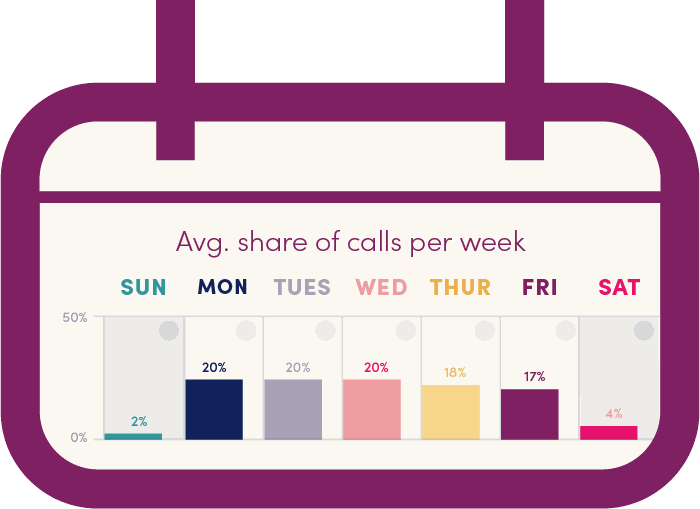
Did you know?
92% of phone calls a business receives represent opportunities—opportunities to win, retain, or lose business, strengthen customer connections, and more.
Yeah, I had no idea either. That is, I didn’t know until a few months ago, when we began work on Ruby’s first-ever call trends report.
We analyzed two years’ worth of phone calls Ruby answered for our small business customers—over 25 million calls in total—to determine what the phone really means for businesses in the 2020s.
What we found might come as a surprise, especially for those of us who use our mobile devices for everything other than their original purpose.
To begin with:
1. Phone calls matter more than ever.

Phone calls matter more now than they have at any other time in history.
Seriously.
Pause and think about it, and it makes sense. In our increasingly remote, automated world, a live conversation between two people is a powerful and special thing.
Perhaps that’s why more and more people are reaching out to businesses over the phone. They want to learn about products and services, ask questions, voice their concerns, and have their needs met in a personal and immediate way.
Sometimes, they don’t want to Google for hours or wait for an email or social media response. They want to talk to a real person, right now—and a phone call is the easiest way to make it happen.
How else can we explain the sheer number of phone calls our customers received over the last two years?
We’re talking about approximately 35,000 calls per day. And with nine out of ten of those calls coming from new or existing customers, business contacts, and other relevant parties (compared to the 8% comprising spam and robocalls), businesses have every reason to pick up the phone.
2. Expectations for 24/7 availability are increasing.
When we began compiling this report, we suspected that we’d see a massive change in the days and times people called due to the pandemic. But while callers’ schedules have changed during the Covid era, a lot of business still happens during, well, business hours.
According to the call trends report:
- The days with the highest volume of calls are Monday and Tuesday
- Most calls come in between 9am and 2pm Pacific Time
- Call activity slows down between 8pm and 6am PT

That said, there’s no denying a change is taking place. Calls outside of traditional operating hours are becoming more frequent, increasing by more than 18% from 2020 to 2021. And our data show that Ruby’s virtual receptionists handle more than 14,500 calls for our customers on Saturdays and Sundays.
For these reasons, an investment in support beyond typical working days and hours could be a smart business decision.
3. Callers of all kinds are looking for deeper, more empathetic service.

People call businesses for lots of reasons. Sometimes they simply want to learn about something or ask a question; other times, they have a specific goal in mind—such as scheduling an appointment, reaching a specific person, or engaging in a transaction.
Whatever the reason they’re calling, a caller is almost always hoping to reach a capable, friendly person on the other end.
When a business doesn’t provide this, the number of frustrated callers is likely to increase.
And that’s bad news.
Currently, about one in every 200 callers is frustrated—and our report shows that number is on the rise. This is likely due to pandemic-related issues such as product and labor shortages, business closures, and more. Unfortunately, given ongoing socioeconomic instability, the trend isn’t likely to stop or slow down soon.
But even if frustrated callers make up a fraction of all the calls your business receives, that doesn’t change the outsized impact they have on your bottom line. After all, a single negative customer experience can lead to significant revenue loss in terms of lost customers, poor references and reviews, and long-term reputational damage.
At the same time, the call trends report also shows an increase in year-round calls in conventionally “seasonal” industries such as education, automotive, home services, and financial service. This indicates consumers are leaning on businesses for ongoing services and consultative relationships rather than one-off sales.
And that’s another reason to make sure the people answering phones provide the responsive, empathetic, trustworthy experiences callers expect.
4. Phone calls are unmatched opportunities to win and retain business.
With more than 1.6 million new opportunities generated for our customers through phone calls last year, it’s clear that calls remain a critical tool for lead generation.
And that’s not including existing customers or clients, or others whose experiences are vital to a business’s success through retention and word of mouth.
The fact is that every call is an opportunity for an organization to stand out, make a positive impression, and win loyalty—or lose business and trust.
But I’ve gone on long enough here. See what calls really mean for your business by exploring our call trends report for yourself.



